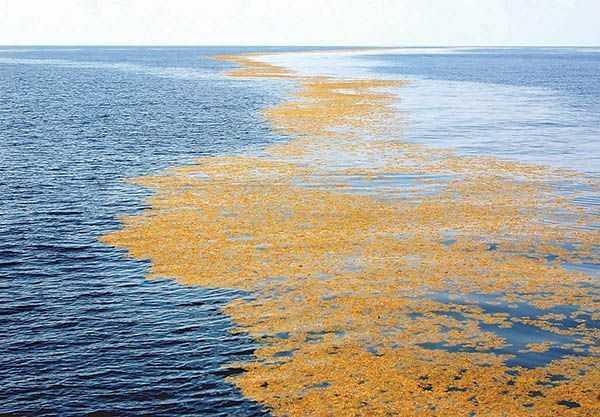We see it most every time we go out on the water, and unless we’re trolling for wahoo or dolphinfish, we probably just take Sargassum weed for granted and don’t give it a second thought.

But after the Deep Water Horizon oil spill, of the many concerns and fears about the impact of that disaster, I think I was most worried about the oil’s impact on the Sargassum. The media bombarded us with “oil in the marsh” or “oil on the beaches” and scores of other impending ecological disasters. But not once did I hear concern about Sargassum.
What I feared most was the oil collecting on the Sargassum, possibly blocking sunlight, or the oil being ingested by the myriad creatures that inhabit these floating ecosystems. I envisioned blackening masses of dying weed, and wondered how long it might take to replenish.
That made me reflect on those resident species, so totally dependent on this habitat. We all know the game fish, like those mentioned above, that depend on this weed. But there are dozens of other finfish that live there. Most noteworthy are tripletails, juvenile billfish, several species of triggerfish, the infamous Sargassum fish, and three or four species of filefish. But there are many species we seldom think about, including a pipefish that lives there and nowhere else. Miniature crabs and shrimps abound, all incredibly camouflaged in that golden tangle that floats at the surface.
I consider Sargassum as valuable as our coastal marshes and submerged seagrasses. Without it you could kiss the populations of many of our favorite big game species goodbye.
Shortly after the spill, our team at the Dauphin Island Sea Lab began sampling Sargassum. We all shared the same concerns and figuratively held our breath during each sampling exercise. We did in fact find evidence that some fishes were ingesting tiny globules of oil, but as time passed our fears began to be allayed. Now, nearly four years later, our confidence grows that those gorgeous mats of seaweed are healthy and here to stay. We continue to be vigilant, and are still actively monitoring the nearshore and offshore surface waters.
Sargassum is really an alga. In some areas like the North Atlantic, the mats are so thick they have actually impaired ship travel, and these areas have become known as the Sargasso Sea. Our American freshwater eels make incredible migrations there, mating, then dying, and are survived by larvae that float for months or years before working their way back toward the coasts.
We don’t have quite the concentrations in the Gulf as in the Atlantic, but some of our “weed lines” can stretch for miles and be hundreds of yards across. Sometimes Sargassum can become attached to hard substrate, where it may support a totally different fauna. I remember snorkeling at the jetties at Panama City many years ago during a particularly rich settling of the weed, and observed countless seahorses entwined in their “branches.”
The next time you are at the beach, if a small raft of Sargassum appears near the surf, grab the kids and shake it out in a bucket, and watch them marvel at the life. And when traveling offshore, take a dip net and hoist some Sargassum onto the deck. When you do you’ll see diversity that rivals a coral reef. It’s during such times we know how valuable this weed is.
Dr. Bob Shipp has served eighteen years on the Gulf of Mexico Fishery Management Council, three terms as chair, and is currently chairman of the Council’s Reef Fish Committee. He is professor and past chair of the Department of Marine Sciences at the University of South Alabama.
[easy-social-share]